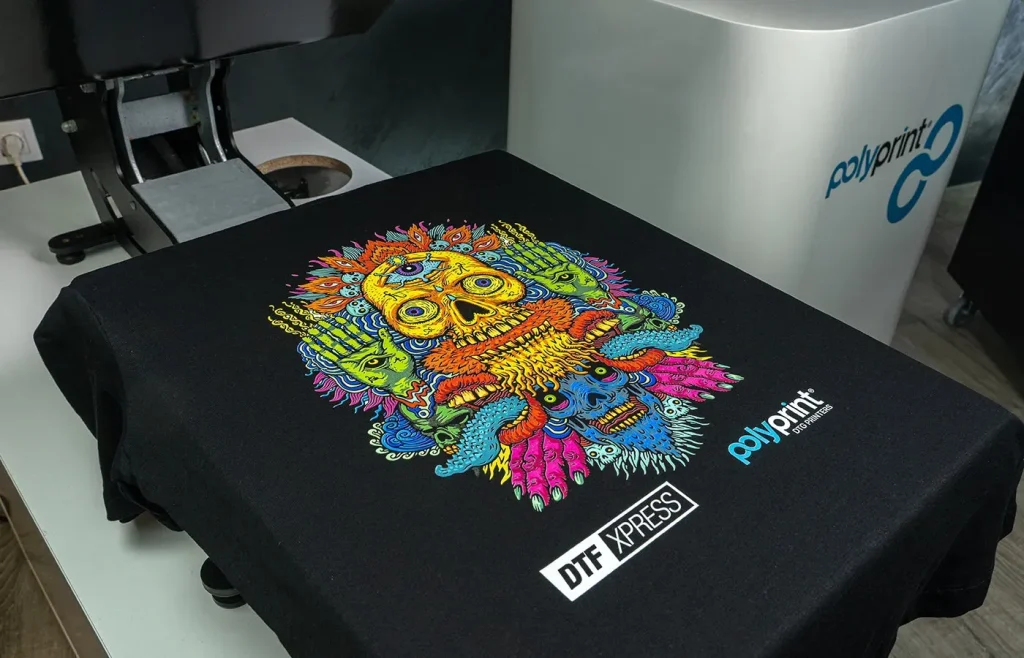DTF printing, or Direct to Film printing, is revolutionizing the custom apparel industry with its innovative and efficient approach to design transfer. This remarkable technology seamlessly combines quality and economy, making it a go-to solution for businesses seeking cost-effective custom printing options. With the ability to produce vibrant, intricate designs on various fabric materials, DTF printing is quickly becoming a favorite among apparel brands and consumers alike. Moreover, as the demand for eco-friendly printing solutions grows, DTF technology stands out due to its sustainable practices, ensuring minimal environmental impact. In this article, we will explore the ins and outs of DTF printing, highlighting its advantages and why it’s set to define the future of custom apparel.
The landscape of apparel manufacturing is evolving, particularly with the emergence of techniques like Direct to Film, which allows for efficient and high-quality printing onto textiles. Often embraced for its versatility, this method is ideal for businesses aiming to cater to diverse fashion needs while managing costs effectively. This contemporary printing process not only supports the creation of intricate designs but also promotes eco-responsibility, attracting environmentally-conscious consumers. With custom apparel printing gaining traction, it’s clear that DTF technology is integral to shaping the future of this dynamic industry. By leveraging these advanced printing methods, brands can innovate while offering personalized fashion solutions.
What Makes DTF Printing a Game Changer for Custom Apparel?
DTF printing has quickly become a leading choice in the custom apparel market due to its unique ability to produce high-quality designs on a variety of fabric types. Unlike traditional methods, DTF uses a transfer film that allows for precise detail and vibrant colors, catering to brands looking to offer detailed custom designs. This capability ensures that businesses can meet the diverse needs of their clientele, from intricate graphics to bold text, all while maintaining the durability and quality that modern consumers expect.
Moreover, the cost-effective nature of DTF printing makes it a game changer for startups and small businesses. Unlike screen printing, which typically requires significant upfront costs for setup and materials, DTF offers a less expensive solution. This reduced financial barrier allows new brands to experiment with designs and styles without committing to large inventory runs, ultimately making custom apparel accessible to a wider audience.
Comparing DTF Technology to Traditional Printing Methods
When evaluating DTF technology alongside traditional printing methods such as screen printing and direct-to-garment (DTG) printing, several significant differences emerge. DTF printing stands out by providing superior quality prints at a lower cost per unit, especially for smaller production runs. This makes it an ideal choice for businesses that target niche markets or that require flexibility in their design offerings. The ability to print on various fabrics enhances DTF’s versatility, further solidifying its position in the custom apparel landscape.
Additionally, DTF printing has demonstrated greater efficiency in terms of production. With traditional screen printing, preparing screens for different designs can be time-consuming and labor-intensive, rendering it impractical for quick turnaround jobs. In contrast, DTF printing allows for rapid setup and production with minimal waste, aligning better with the fast-paced demands of the fashion industry where trends can change overnight.
The Eco-Friendly Aspect of DTF Printing
As sustainability becomes increasingly important in consumer purchasing decisions, DTF printing emerges as a leading eco-friendly choice in custom apparel printing. The DTF process utilizes eco-friendly inks with lower environmental impact compared to traditional screen printing methods that often involve harsh chemicals and solvents. These inks also allow for a reduced carbon footprint, appealing to an environmentally conscious market.
Furthermore, the precision of DTF printing minimizes material waste, contributing to a more sustainable production process. By reducing the quantities of ink and fabric waste generated during production, businesses can align their operations with eco-friendly principles, thus attracting a demographic that values sustainable practices. This not only enhances brand reputation but also secures a loyal customer base committed to supporting environmentally responsible companies.
DTF Printing: A Cost-Effective Solution for All Businesses
Cost-effectiveness is a hallmark of DTF printing, making it an attractive choice for businesses ranging from small startups to established brands. The ability to print high-quality designs without the hefty upfront costs associated with traditional screen printing makes DTF uniquely positioned to support diverse business operations. This adaptability allows businesses to offer customization without passing on high costs to consumers, maintaining competitive pricing in an increasingly saturated market.
In addition, DTF printing supports on-demand production, which mitigates the risks associated with overstocking and unsold inventory. By offering flexibility in sizes and designs without the commitment to a large print run, businesses can respond quickly to market trends and consumer demands, which is essential in the ever-evolving fashion landscape.
Understanding the Market Growth of DTF Printing
The custom apparel market is undergoing a significant transformation as personalization becomes a key driver of consumer demand. DTF printing is positioned to capitalize on this trend, with forecasts indicating substantial growth in the sector driven by the need for unique, tailored designs. As consumers increasingly seek to express their individuality, brands that adopt DTF technology can meet these demands effectively and profitably.
Moreover, with advancements in DTF technology facilitating easier and more efficient printing processes, businesses can keep pace with this rising demand. Enhanced production capabilities enable companies to offer limited-edition items or seasonal collections quickly, maintaining relevance and engagement in a market where styles shift rapidly. This agility in responding to consumer wants is crucial for sustained growth and success.
The Future of DTF Printing in the Apparel Industry
As we look to the future, DTF printing is set to play an increasingly pivotal role in shaping the apparel industry. With a surge of technological advancements and consumer preferences shifting towards personalized products, DTF offers a unique blend of quality, speed, and sustainability that is hard to overlook. Coupled with its versatility across various fabric types, DTF strongly positions itself as a dominant force in the printing market.
Additionally, as more companies integrate eco-friendly practices into their operations, DTF printing’s sustainable qualities will become even more appealing. The trend towards green production processes will push DTF to the forefront, encouraging a new wave of innovations and improvements. This approach not only aligns with consumer values but also drives brand loyalty and promotes positive market growth, ensuring that DTF printing is not merely a trend, but rather the future of custom apparel production.
Frequently Asked Questions
What is DTF Printing and how does it work?
DTF Printing, or Direct to Film printing, is a modern textile printing method that involves printing designs onto a film, which is later transferred to fabric using heat and pressure. This process allows for intricate designs and vibrant colors to be applied to a wide variety of materials, making DTF an ideal choice for custom apparel.
What are the advantages of using DTF Printing for custom apparel?
DTF Printing offers numerous benefits for custom apparel, including versatility across fabric types, cost-effectiveness for both small and large runs, high-quality and durable prints that resist fading, and eco-friendly practices that reduce environmental impact.
How does DTF Printing compare with traditional printing methods?
Compared to traditional printing methods like screen printing and DTG, DTF Printing stands out for its ability to handle small runs with intricate designs effectively and at lower costs. It also provides superior durability and print quality, making it a preferred choice in the custom apparel market.
Is DTF Printing an eco-friendly option for custom apparel?
Yes, DTF Printing incorporates sustainable inks and minimizes waste during the printing process, positioning it as an eco-friendly choice for businesses and consumers looking to reduce their environmental footprint while enjoying high-quality custom apparel.
What types of fabrics can be used with DTF Printing technology?
DTF Printing is versatile and can be applied to a variety of fabrics including cotton, polyester, blends, and more. This allows for a wide range of custom apparel options, from t-shirts to bags, catering to diverse customer preferences.
What should I consider when choosing DTF Printing for my business?
When considering DTF Printing for your business, evaluate factors such as print quality, cost-effectiveness for different order sizes, versatility with fabric compatibility, and the sustainability practices involved in the printing process to align with your brand values.
| Key Aspects | Description |
|---|---|
| What is DTF Printing? | DTF Printing is a modern process transferring designs from a film onto textiles using heat and pressure. |
| Key Benefits | 1. Versatility: Can be applied to various fabric types. 2. Cost-Effectiveness: Ideal for small and large runs without high setup costs. 3. Quality and Durability: Sharp details, vibrant colors that withstand washing. 4. Environmental Benefits: Incorporates sustainable inks and reduces waste. 5. Market Growth: Increasing demand for personalized products. 6. Technological Advancements: Innovations improve efficiency and accessibility. |
| Comparison with Other Methods | Compared to screen printing, DTF is more effective for small runs. Offers better durability than heat transfer. More economical than direct-to-garment printing for bulk orders. |
Summary
DTF printing represents a significant evolution in custom apparel, offering businesses a powerful solution for producing high-quality, vibrant designs efficiently. By utilizing a unique film transfer method, DTF printing combines versatility and durability with cost-effectiveness, making it suitable for a wide range of textiles. As consumer demand for personalized clothing continues to rise, DTF printing stands out as a sustainable and advanced technique that not only meets these expectations but also supports eco-friendly practices in the apparel industry. The future of custom apparel is undoubtedly intertwined with advancements in DTF printing technology.



